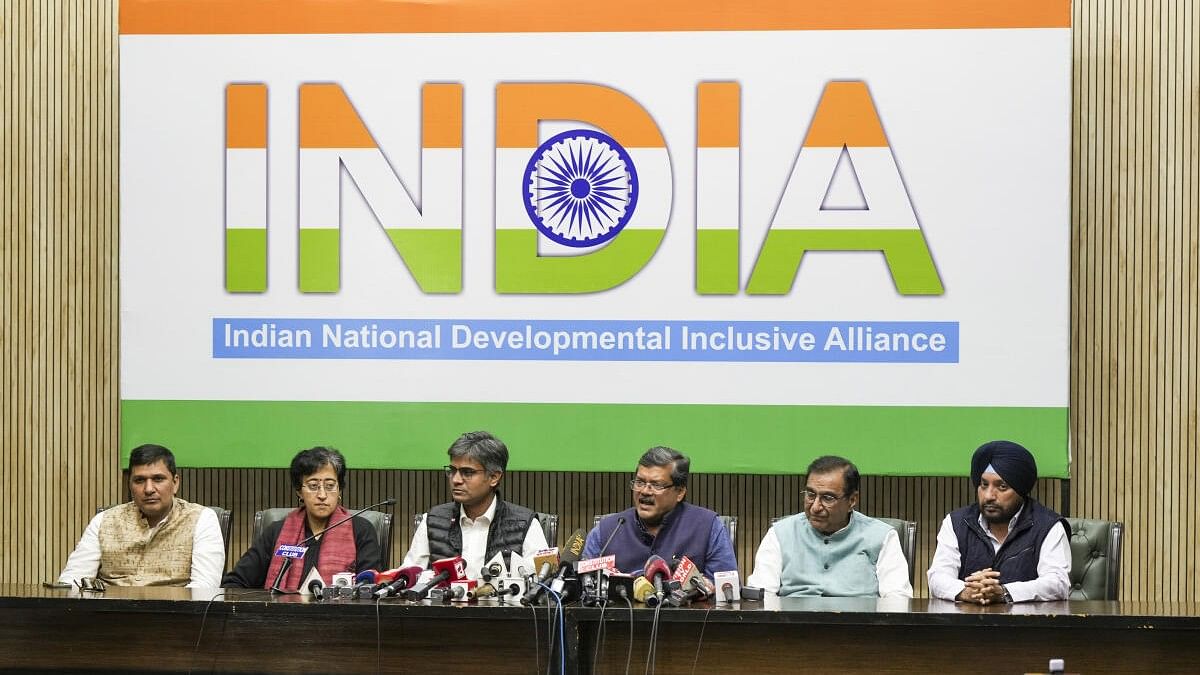
AAP leaders Saurabh Bharadwaj, Atishi Singh and Sandeep Pathak with Congress leaders Mukul Wasnik, Deepak Babaria and Arvinder Singh Lovely during a joint press conference, in New Delhi, Saturday, Feb. 24, 2024.
Credit: PTI Photo
Born in October 2012 out of a severe revulsion towards the Congress’ politics, the Aam Aadmi Party (AAP) joined hands with the grand old party for the upcoming Lok Sabha elections, on February 24.
AAP and the Congress have sealed a seat-sharing deal to take on the ruling Bharatiya Janata Party (BJP) in Delhi, Gujarat, Haryana, Goa, and Chandigarh. The seat-sharing talks between the two regarding Assam are in the final stages.
The anti-corruption movement launched by Arvind Kejriwal with activist Anna Hazare as its face became the primary reason for the downfall of the Congress-led United Progressive Alliance (UPA) government in 2014. The protests at Jantar Mantar and Ramlila Maidan in Delhi are widely believed to have spelt the death knell for the Manmohan Singh government at the Centre and the Shiela Dikshit government ruling Delhi.
Prime Minister Narendra Modi and the BJP reaped the benefits of the agitation by India Against Corruption (IAC) in the 2014 Lok Sabha elections while the grand old party suffered one of its worst-ever electoral defeats in its history. The BJP bagged 282 seats on its own with the National Democratic Alliance (NDA) winning 335 of the total 543 Lok Sabha seats. In 2014, the Congress won just 44 seats, and registered its worst-ever electoral performance in its history.
Congress leaders then alleged that the anti-graft stir, helmed by Kejriwal, was orchestrated by the Rashtriya Swayamsewak Sangh (RSS), the ideological mentor of the BJP.
From being called BJP’s B-team, AAP soon turned against the saffron party with Kejriwal unsuccessfully challenging Modi from Varanasi in 2014. Before that, AAP and the Congress briefly buried their hatchets and came together to form a coalition government in Delhi after the 2013 assembly elections threw a hung verdict. That government lasted all but 49 days.
Since then, AAP has been fighting both the BJP and the Congress on multiple fronts, and expanded its national footprints. Not only has AAP occupied the space ceded by the Congress in Delhi, but it successfully uprooted the grand old party from power in Punjab. In other states too, the Congress appears to be a soft target for AAP as compared to the BJP which has a well-oiled and fighting-fit election machinery.
The two parties came close to forging an alliance in Delhi ahead of the 2019 Lok Sabha elections, but an adamant AAP was unwilling to concede more than two of the seven seats to the Congress.
Much has changed since then. This time, there was a sense of eagerness and willingness to walk an extra mile on both sides to stop Modi’s juggernaut.
The tie-up with the Congress in Gujarat and Haryana is a win-win for AAP as it seeks to strengthen its footprints in these states. In Delhi too, the two parties are expected to give a tough fight to the BJP provided they transfer their vote share to each other. The Congress could gain from the alliance in Delhi where the party failed to win a single seat in the 2014 and 2019 (Lok Sabha), and in the 2015 and 2020 (assembly) elections.
Both parties have strategically and smartly avoided any seat sharing in Punjab where both the ruling and the Opposition space is with them. A tie-up would have resulted in an erosion of the Opposition space and would have given the BJP a chance to strengthen its position there.
But for the fresh agitation by farmers, the BJP would have by now announced its alliance with the Shiromani Akali Dal (SAD). It has now decided to put it in abeyance. The SAD snapped its 24-year-old alliance with the BJP in 2020 over the now-repealed controversial farm laws.
For now, both AAP and the Congress argue that it is imperative for all likeminded political parties to join hands and save democracy, constitution and, secularism, which according to them, are currently under threat by the BJP.
Political compulsions and electoral arithmetic forced the Congress and AAP to set aside their past bitterness and shake hands to keep the Modi-led BJP at bay.
Aurangzeb Naqshbandi is a senior journalist who has been covering the Congress for 15 years, and is currently associated with Pixstory.
(Disclaimer: The views mentioned above are the author's own. They do not necessarily reflect the views of DH.)